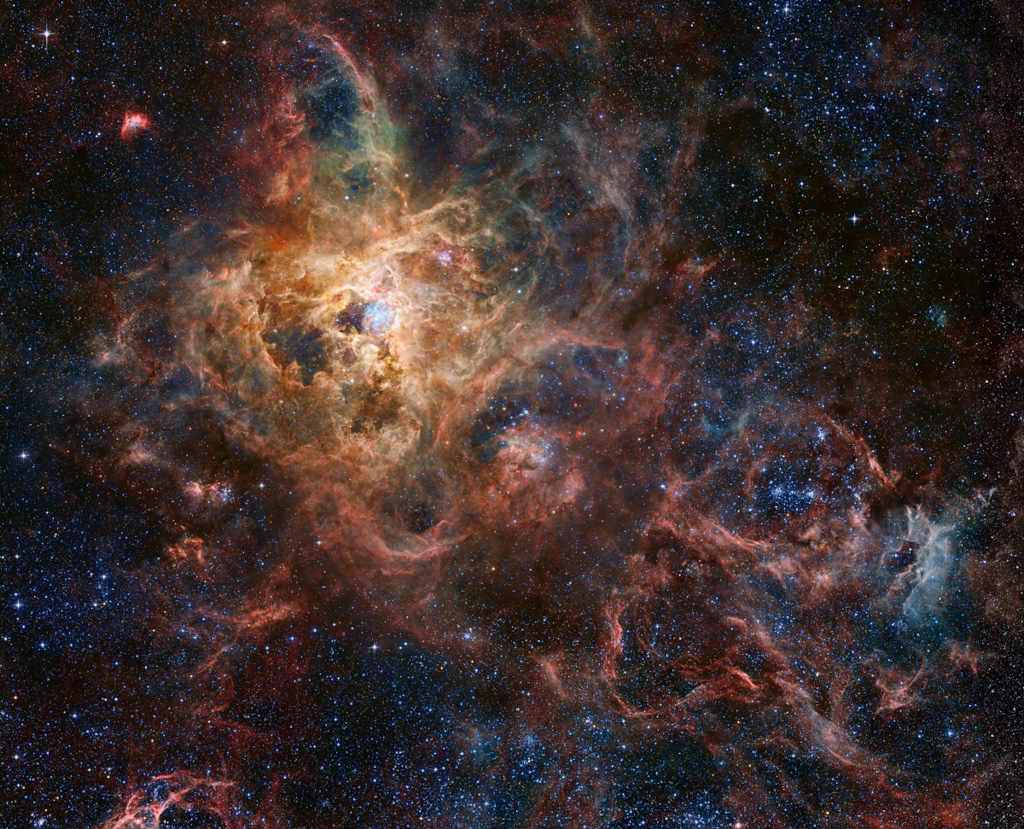2024年3月8日
The Tarantula Zone
Image Credit & Copyright: Processing – Robert Gendler
Data – Hubble Tarantula Treasury, European Southern Observatory, James Webb Space Telescope, Amateur Sources
Explanation: The Tarantula Nebula, also known as 30 Doradus, is more than a thousand light-years in diameter, a giant star forming region within nearby satellite galaxy the Large Magellanic Cloud. About 180 thousand light-years away, it’s the largest, most violent star forming region known in the whole Local Group of galaxies. The cosmic arachnid sprawls across this magnificent view, an assembly of image data from large space- and ground-based telescopes. Within the Tarantula (NGC 2070), intense radiation, stellar winds, and supernova shocks from the central young cluster of massive stars cataloged as R136 energize the nebular glow and shape the spidery filaments. Around the Tarantula are other star forming regions with young star clusters, filaments, and blown-out bubble-shaped clouds. In fact, the frame includes the site of the closest supernova in modern times, SN 1987A, at lower right. The rich field of view spans about 2 degrees or 4 full moons in the southern constellation Dorado. But were the Tarantula Nebula closer, say 1,500 light-years distant like the Milky Way’s own star forming Orion Nebula, it would take up half the sky.
Tomorrow’s picture: light-weekend
蜘蛛星云的国度
影像提供与版权: 影像处理 – Robert Gendler
数据 – Hubble Tarantula Treasury, European Southern Observatory, James Webb Space Telescope, Amateur Sources
说明: 跨幅1,000多光年、亦名为剑鱼座30的蜘蛛星云,是邻近的伴星系─大麦哲伦星系内的庞大恒星形成区。这团约18万光年远的星云,也是本星系群里最大及最活跃的恒星形成区。在这幅整合大型太空及地面望远镜影数据的精采影像里,这只宇宙级的节肢动物占住了整个视野。在蜘蛛星云(NGC 2070)里,强烈的辐射、恒星风及中心年轻大质量恒星群R136的超新星爆炸震波,除了激发星云发出辉光之外,也雕塑出酷似蛛脚的丝状云气。蜘蛛星云周围的其他活跃的恒星形成区,通常也拥有年轻星团、云气丝和气泡状云气等结构。在这片视野里,离我们最近的现代超新星SN 1987A,就发生在影像右下角的位置。这片天体拥挤的视野,呈现南天的剑鱼座方向约2度(4个满月)的天区。如果蜘蛛星云更近一点,例如和邻近的恒星形成区猎户座星云距离相当,位在1,500光年之处的话,那它会占据半个天空。
明日的图片: light-weekend








4 Comments